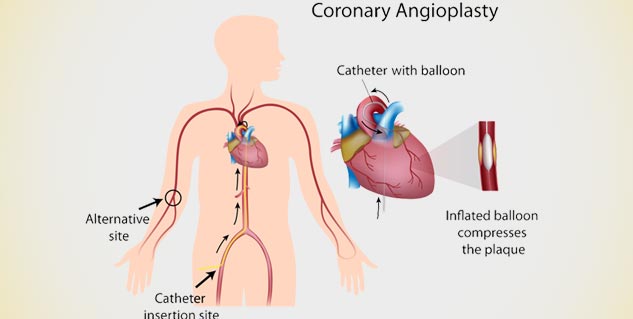
Angioplasty is a procedure done to open an area of arterial blockage with the help of a catheter. The catheter has an inflatable small sausage-shaped balloon at its tip. When the catheter is threaded through a blood vessel in the groin or arm into the affected coronary artery, the technique is also called PTCA or Percutaneous Transluminal Coronary Angioplasty.
Table of Content:-

How is Angioplasty Done?
Before coronary angioplasty is done, your doctor will do coronary angiography. This procedure helps the doctor to know the location and extent of the blockages in your coronary (heart) arteries. For the test, a dye is injected and special x rays are done to show the insides of your arteries. During the procedure, a thin, flexible catheter is inserted into an artery, usually, in the groin (upper thigh). The catheter is carefully threaded through the blood vessel in the groin into the coronary artery. The doctor then injects a special dye through the catheter. This dye is visible on x-ray pictures. X-ray pictures are done as the dye flows through your coronary arteries. These X-ray pictures can show if there is any blockage, its location and severity.
If there is a blockage in your coronary artery, angioplasty may be done. During angioplasty, a thin, flexible catheter with a balloon at its tip (a balloon catheter) is inserted into the affected artery. The catheter is usually threaded through a blood vessel in the groin into the affected coronary artery. After the catheter is in place, the balloon is inflated. The pressure during initial inflation is usually 1 to 2 times that of the atmosphere, which may be gradually increased to 8 - 12 and, sometimes, to as high as 20 atmospheres. The pressure used during inflation depends upon the type of balloon that is used. The handheld inflation syringe that is used has markers, which help the doctor to determine the pressure. Usually, the balloon is kept inflated for 1/2 to 2 minutes at a time and later deflated until the next inflation. The balloon is inflated intermittently so that blood flows through the artery when the balloon is deflated. This procedure compresses the plaque in the artery against the wall and improves blood flow through the artery. If needed, your doctor may administer nitroglycerin solution to prevent spasm of coronary arteries.
After this, a small mesh tube called a stent is placed in the artery. The stent is present around the deflated balloon catheter before it is inserted into the artery. When the doctor inflates the balloon to compress the plaque, the stent also expands and attaches to the artery wall. The stent is helpful as it supports the inner wall of coronary artery and decreases the risk of subsequent narrowing or blockage of the artery. Some newer stents called drug-eluting stents have medicine in them that is slowly and continuously released into the artery. These stents aim to prevent scar tissue from blocking the artery following angioplasty.
Read Next
How do you Lower Blood Pressure?
How we keep this article up to date:
We work with experts and keep a close eye on the latest in health and wellness. Whenever there is a new research or helpful information, we update our articles with accurate and useful advice.
Current Version